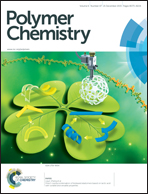Poly(N-acryloyl ciprofloxacin-co-acrylic acid) grafted magnetite nanoparticles for microbial decontamination of collagen solution: have we conquered the problem of antimicrobial residues?†
Abstract
Widespread concern over antimicrobial toxicity and resistance development necessitates the thorough recovery of antimicrobial compounds from decontaminated collagen. Herein, ciprofloxacin molecules were acryloylated by reaction of the secondary amine in 7-piperazinyl substituent with acryloyl chloride, and then covalently immobilized, for the first time, on the vinyl-functionalized Fe3O4 nanoparticle surface via graft copolymerization with acrylic acid, in an effort to design a magnetically-recoverable nanocomposite potentially applicable for microbial decontamination of collagen solution. Unlike previous magnetite-supported antimicrobials invariably involving the release of antimicrobially-active component, these immobilized ciprofloxacin moieties proved non-leachable, in whole or in part, from the magnetite core, exerting antimicrobial activity as free ciprofloxacin, and thus could be thoroughly recovered from decontaminated collagen solution under magnetic fields. Also, it was found that the unique triple-helical conformation and, hence, bioactive properties of tropocollagens remained intact after decontamination using such recoverable antimicrobials. This proof-of-principle study aims to shed light on a long-standing dilemma in the collagen community: how to decontaminate collagen using antimicrobial compounds without being subject to antimicrobial residues?


 Please wait while we load your content...
Please wait while we load your content...